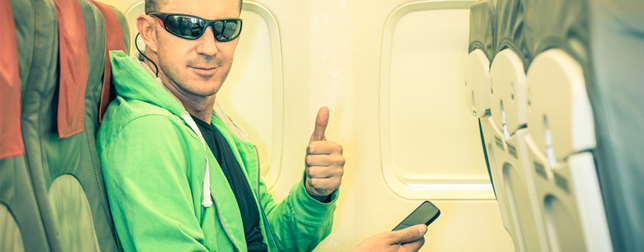Holidays are among us! Not only is there cheer but many safe travels to families located across the world. On my last flight to America, I noticed a few flight attendance were wearing activity trackers. Airlines have started to embrace wearable devices all types; such as smart glasses, smart watches and smart textiles to bring joy to long flights.
Smart Glasses
In 2014, Virgin Atlantic announced they will be using Google Glass at the Upper Class Wing at London Heathrow airport. Their purpose is to test how wearable technology to enhance passengers’ travel experiences as well as to improve efficiency. With the help of Google Glass, Virgin Atlantic staffs are able to greet passengers by name at the front door of the terminal. Simultaneously, the staff can update passengers on latest flight information; like weather and local events occurring at their destination. One of the best benefits are being able to translate into any language information.
Another form of smart glasses is Aero Glass; a unique smart glass for pilots. Aero Glass provides solutions to a pilot’s need. It accomplishes this by visualizing terrain, providing navigation, air traffic information, and current weather. A cool feature is its ability to provide airspace information by accessing vital safety procedures and protocols. A pioneering aspect to Aero Glass is that it doesn’t require a compatible smartphone or tablet assessment. In addition, Aero Glass is the first glass to bring augmented reality to pilots providing an unparalleled 3D experience in the cockpit.
Additionally, Epson has created another smart glass for pilots. It’s called Epson Moverio BT-200 and it is packed with sensing technology; including GPS system, compass, accelerometer, gyroscope and a front camera. If you want to experience the real Epson Moverio BT-200, come see their demo table at WT | Wearable Technologies Conference 2016 Europe in Munich on 26th -27th January.
Sony Smart Watch
Along with Google Glass, Sony Smart Watch has struck up a second partnership with Virgin Atlantic, bringing its Smart Watch to airline staff in an effort to improve customer service. Sony Smart Watch is used to support operational activities. Sony also launched the world’s first application that allows passengers to carry boarding pass and flight information on their wrist. It means that the watch allows passengers to display a 2D boarding card barcode on the watch’s display, as well as details of upcoming flights.
Smart Uniform
UK airline EasyJet has publicly released their collaboration with CuteCircuit. Together they will bring smart uniforms covered with LED lights and built-in sensors to flight attendance by early next year. There will be microphones built in the uniforms so engineers, crew and pilots can easily talk to each other. In addition, LEDs on the cabin crew uniforms will display the flight number and destination information. The LED illuminated hems also provide light in cases of emergency. Air quality sensors and a barometer are also embroidered into the uniforms to help engineers monitor their work environment and create a map of quality in different cities.
Using wearable technology to help facilitate a more seamless travel process is still in the early stages. However, the belief that it will have an influence on airline travel is proving successful. At present, enterprises appear to be taking advantaged of wearable technology as a tool to improve business efficiency. However, in the long run, it is expected to bring all passengers a fancy travel experience with comfort, convenience and entertainment.












